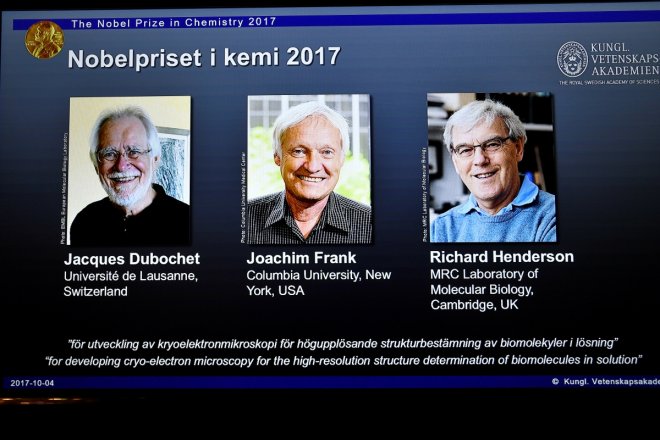
The Royal Swedish Academy of Science has declared the Nobel Prize in chemistry 2017 award on Oct. 4, to Jacques Dubochet, Joachim Frank and Richard Henderson, for the development of cryo-electron microscopy which creates 3-dimensional images of biomolecules. This simplifies and improves imaging of the biomolecules.
The new technology is useful in taking pictures of live bio-molecules by freezing them while in motion. It helps in creating 3D images of the life processes, including the movement of proteins and molecules. This gives a rapid advancement in our study of bio-system in organisms and helps in the development of pharmaceutical research.
Peter Brzezinski, a member of Nobel Committee for Chemistry has said to the media, "It's like frames in a movie. Each of these pictures represents a frame and they can be put together into a movie and we can see what the molecules do."
The cryo-electron microscope has helped in the study of Zika virus by generating 3D images of the proteins which are antibiotic resistant. This has helped in finding the proteins which made the disease deadly. Earlier, these proteins couldn't be mapped and remained as opaque regions in the cells.
The invention has been regarded as a scientific breakthrough as it helps to visualize objects invisible to human eyes.
The electron microscopes were not very useful in studying life system in cellular level as its powerful beams would destroy the life materials in cells. But it was quite often used to study the dead matter. Richard Henderson was able to create a 3D image of a protein at its atomic resolution using an electron microscope in 1990. This has led to further research in the segment.
Joachim Frank developed a method during 1975 and 1986 which made sharp 3D images by using merger of 2D images from an electron microscope.
Jacques Debochet added water to an electron microscope. The water evaporated in the molecules vacuum and made the cellular system collapse.
Jacques later learned the technique to fast cool the water in the molecular system which allowed the molecules to restructure in its original condition.
Further research led to producing the 3D structure images of the biomolecules in its original atomic resolution. The research got the desired results by 2013 and the researchers started intensively using the instrument for cellular research and using it for human health benefits.
John Aqvist, a Nobel committee member told Reuters, "The use of these methods has completely revolutionized structural biology so everyone now wants to buy this type of equipment and start this type of research on their own."









